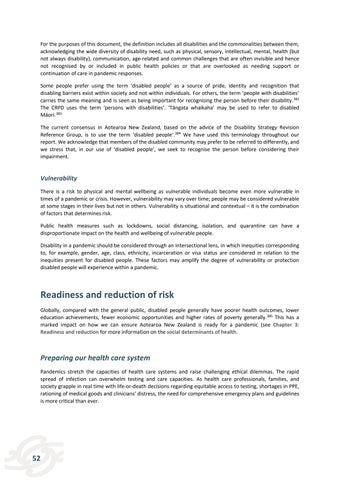For the purposes of this document, the definition includes all disabilities and the commonalities between them, acknowledging the wide diversity of disability need, such as physical, sensory, intellectual, mental, health (but not always disability), communication, age-related and common challenges that are often invisible and hence not recognised by or included in public health policies or that are overlooked as needing support or continuation of care in pandemic responses. Some people prefer using the term ‘disabled people’ as a source of pride, identity and recognition that disabling barriers exist within society and not within individuals. For others, the term ‘people with disabilities’ carries the same meaning and is seen as being important for recognising the person before their disability. 382 The CRPD uses the term ‘persons with disabilities’. ‘Tāngata whaikaha’ may be used to refer to disabled Māori. 383 The current consensus in Aotearoa New Zealand, based on the advice of the Disability Strategy Revision Reference Group, is to use the term ‘disabled people’. 384 We have used this terminology throughout our report. We acknowledge that members of the disabled community may prefer to be referred to differently, and we stress that, in our use of ‘disabled people’, we seek to recognise the person before considering their impairment.
Vulnerability There is a risk to physical and mental wellbeing as vulnerable individuals become even more vulnerable in times of a pandemic or crisis. However, vulnerability may vary over time; people may be considered vulnerable at some stages in their lives but not in others. Vulnerability is situational and contextual – it is the combination of factors that determines risk. Public health measures such as lockdowns, social distancing, isolation, and quarantine can have a disproportionate impact on the health and wellbeing of vulnerable people. Disability in a pandemic should be considered through an intersectional lens, in which inequities corresponding to, for example, gender, age, class, ethnicity, incarceration or visa status are considered in relation to the inequities present for disabled people. These factors may amplify the degree of vulnerability or protection disabled people will experience within a pandemic.
Readiness and reduction of risk Globally, compared with the general public, disabled people generally have poorer health outcomes, lower education achievements, fewer economic opportunities and higher rates of poverty generally. 385 This has a marked impact on how we can ensure Aotearoa New Zealand is ready for a pandemic (see Chapter 3: Readiness and reduction for more information on the social determinants of health.
Preparing our health care system Pandemics stretch the capacities of health care systems and raise challenging ethical dilemmas. The rapid spread of infection can overwhelm testing and care capacities. As health care professionals, families, and society grapple in real time with life-or-death decisions regarding equitable access to testing, shortages in PPE, rationing of medical goods and clinicians’ distress, the need for comprehensive emergency plans and guidelines is more critical than ever.
52


